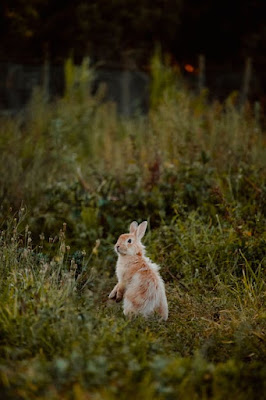The practice of keeping these animals as a source of meat is very limited in West Africa although some rabbits are kept for their fur.
RABBITS
The New Zealand White, Dutch, Norfolk and Flemish Giant are rabbit breeds which are kept in some parts of West Africa. These animals are particularly sensi-tive to adverse weather conditions and are therefore kept in hutches, which are usually made of wood and wire mesh, to protect them from sun, wind, rain and predators.
HOUSING
The type of housing provided will depend mainly on the number of rabbits being raised; for small numbers individual hutches kept in a sheltered place are adequate but for larger numbers a barn or shed with internal partitions or cages is preferable. The flooring of hutches or cages may be of fine wire mesh or wooden slats which are closely spaced. Individual hutches may be 1 m in length, 0.6-1 m in width and about 0.6 m in height. A general recommendation for floor area for young rabbits is 0.5-0.7 m", for adults 0.7-0.9 m2. Air circulation is important, and hutches should be raised at least 0.6 m above the ground level.
Outside hutches should have a waterproof covering with wire mesh sides. The covering should project at least 15 cm beyond the sides of the hutch to give protection from rainfall and it may be necessary to add a layer of thatch to minimise the temperature within the hutch during hot weather.
Each hutch should be provided with a nesting box and water and feeding containers. The nesting boxes should be easily accessible from the main hutch and should be large enough to accommodate the female rabbit and her litter. Both hutch and nesting box should be fitted with doors large enough to permit ready access for cleaning and feeding.
FEEDING
Rabbits are able to digest a wide range of food material but the following are most suitable.
GRASS AND LEGUMINOUS HAY such as groundnut, cowpea and soya bean haulm is more nutritious than grass and should be supplied when available.
GREEN VEGETABLES These should be washed before feeding but almost any leafy vegetables can be used although an excess may be harmful.
ROOTS such as sweet potatoes should be boiled before feeding.
GRAIN CROPS Guinea corn, millet, maize and rice may be used either whole or after grinding. Bran may also be supplied in moderate amounts.
CONCENTRATES such as cake of groundnut, palm kernel, cottonseed and soya bean provide a useful source of protein which is necessary to compensate for the carbohydrate content of many other types of feed.
MINERALS AND WATER Salt licks should be provided to prevent deficiencies, also a regular supply of clean water. Crushed burnt bones may also be supplied to each hutch to maintain good teeth and gums.
Also Read:
SHEEP & GOATS (THE FEEDING, HOUSEING AND THE SHEDS)
General Management
These animals are often kept in schools and for laboratory experiments, more rarely as a source of food. They reproduce rapidly, one female may rear as many as ten young each year. The female guinea pig may produce her first litter at an age of 4 months and generally ceases to breed after reaching an age of 2 years.
The breeding sows are normally kept separate from the boar, as the male guinea pig is generally called, after they become pregnant and until the litter is weaned; the male is then returned to the hutch or pen so that the female can be mated. The alternative is to allow the boar to remain with the females throughout; this results in more frequent litters but the young guinea pigs may be neglected, due to the attention of the boar to the sows; the mortality rate is generally higher than it is if the boar is kept in a separate cage.
One boar is generally able to service up to 12 sows.
HOUSING
Guinea pigs may be kept in hutches similar to those recommended for rabbits, being constructed of wire mesh netting sides, wooden supports and a waterproof roof. The dimensions may be approximately 1,4 m wide, 0.6 m deep and 1.8 m in height. A hutch of this size will accommodate about 10 sows, one boar and several young guinea pigs.
For larger numbers, pens which can take up to 25 adult animals should be constructed in a large shed or weatherproof building, preferably with concrete flooring. Each pen should provide a floor area of 1.5m for every ten adult animals. Pens are concovering of wire mesh, with wooden supports. Adjustable partitions should be provided to allow for a variation in numbers within any particular pen.
Bedding materials, which are regularly changed, should be provided for each pen and the walls of the building should be provided with windows to allow adequate ventilation. Guinea pigs areparticularly sensitive to draughts and excessively high temperatures.
FEEDING
Green vegetables, particularly leafy types, grass and hay should be supplied daily; this can be supplemented by roots of sweet potato and crushed cereal grains mixed with water. A supply of fresh drinking water should always be available.


